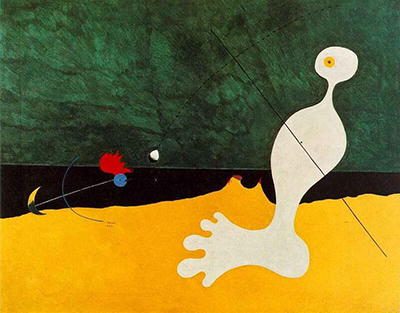The mid-1920s were dominated by two series of paintings which underlined the imagination of Joan Miro, firstly the Dream series and secondly the Imaginary Landscapes. He worked on the two at the same time, despite their clear differences.
Miro tended to spend his summers at the family farm in Catalonia and it was here that he produced 14 artworks for the Imaginary Landscape series, spread over two years. Person Throwing a Stone at a Bird had already been laid out in an earlier drawing in one of his many notebooks. The most obvious comparison between the two series is that the forms are much clearer in paintings such as Person Throwing a Stone at a Bird, with an obvious demarkation of the different parts of the background. You will see three tones of colour which lay out the land, sea and sky with yellow, black and green. The title of this piece allows us to quickly identify the three main elements, namely the person to the right hand side, the stone and the bird.
The figure is constructed from a bowling pin with cyclops, whilst the bird is also typically abstract and surrealist in form, produced in a similar way to the sardine in The Hunter (Catalan Landscape), which also appeared at around the same point in his career. The Museum of Modern Art owns this painting, alongside a large number of other significant pieces from his career. It is believed to have been purchased in 1937, whilst others were actually gifted by the artist himself or bequethed by private owners at a later date. A study drawing on which this composition was based is owned by the Fundacio Joan Miro in Barcelona, which itself holds a large number of his notebooks that provide an invaluable insight into his working processes.
The bright colours and clear lines make this artwork particularly suitable as an art print and it remains one of the most popular choices for reproductions from Miro's large output of work. The abstract style of his work and clean shapes has ensured that his style works well even with smaller prints, where other artists would not be as suitable because of the greater detail that they used. Many will enjoy his work without really understanding the meanings of each figure or object, with colour being another strength of Miro's work.




